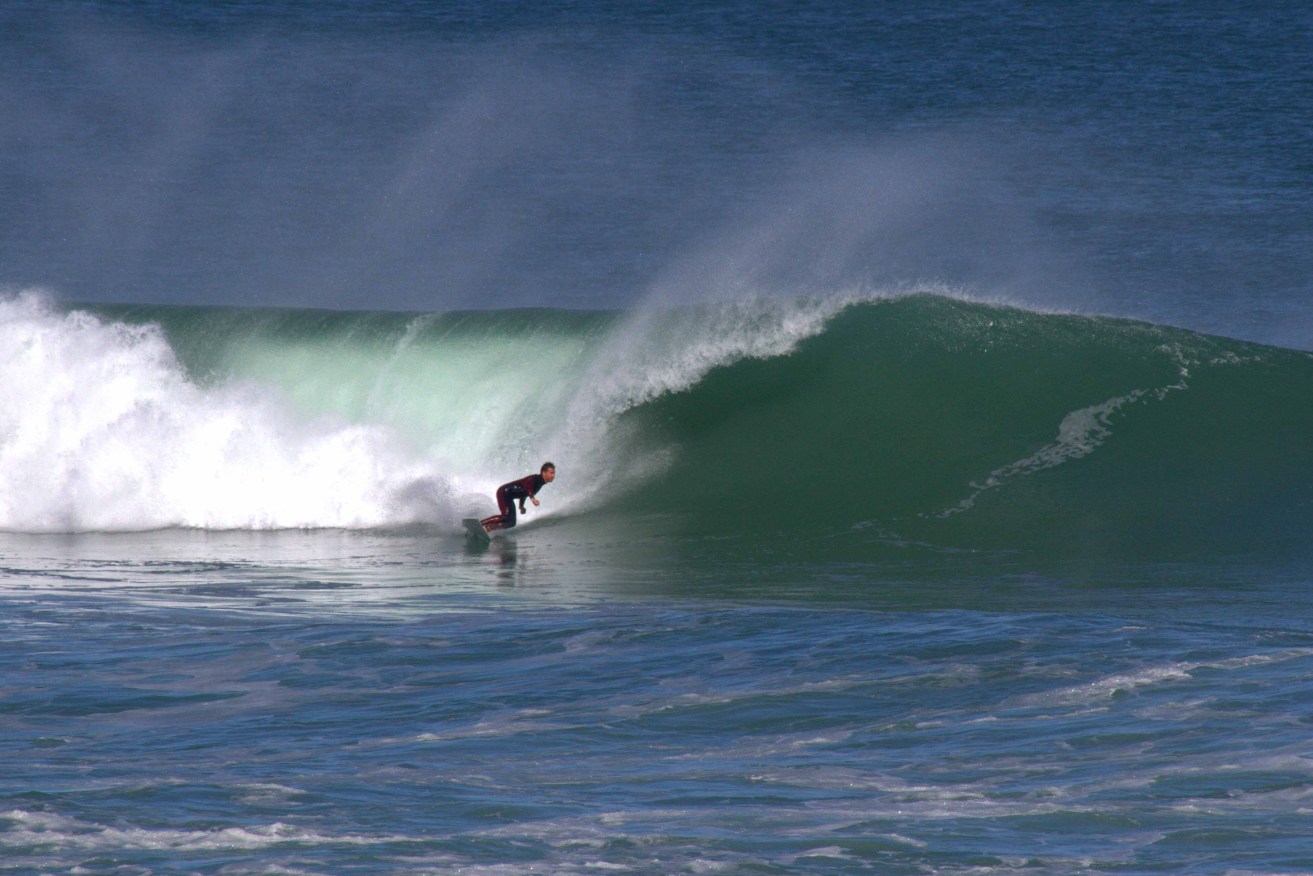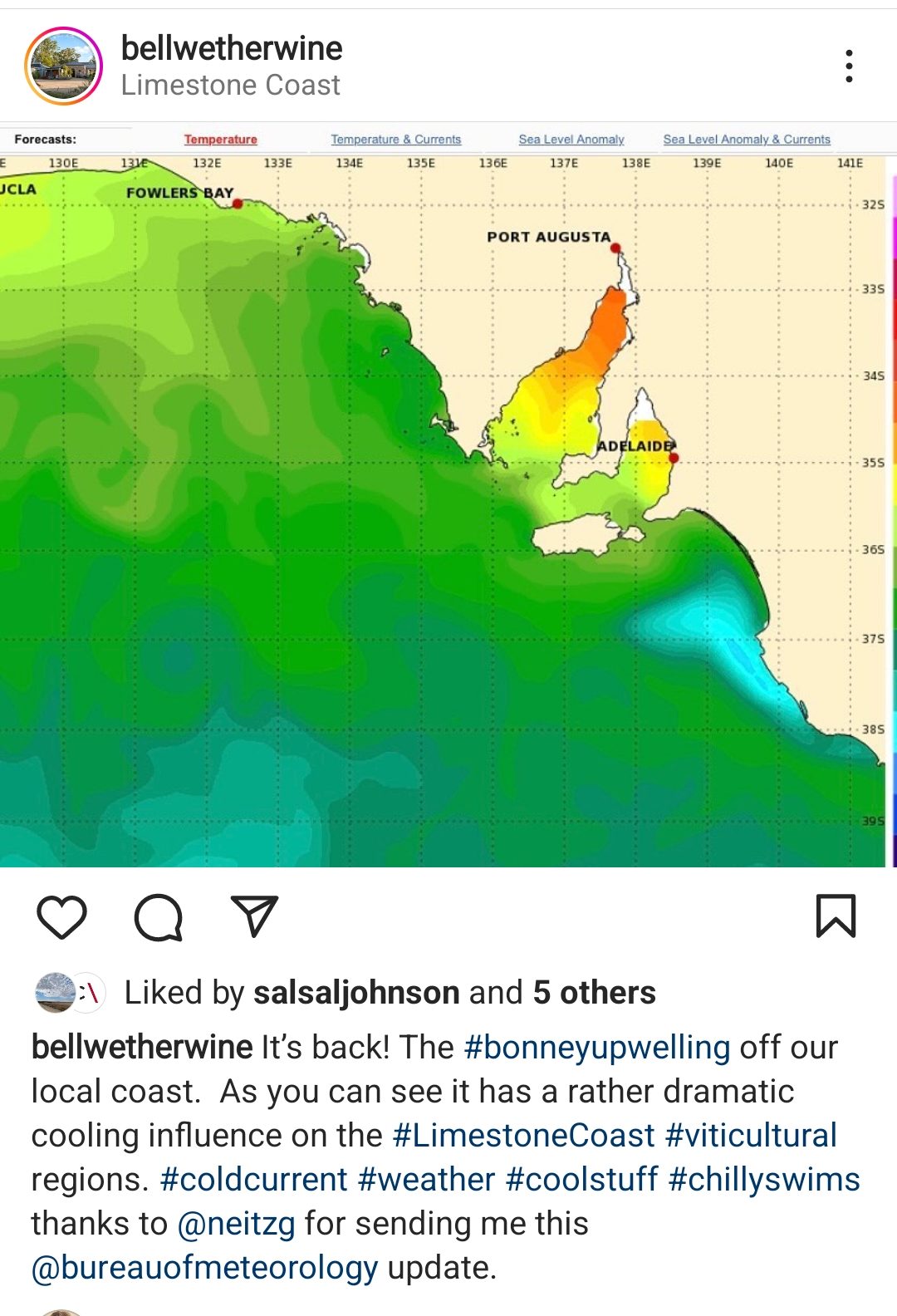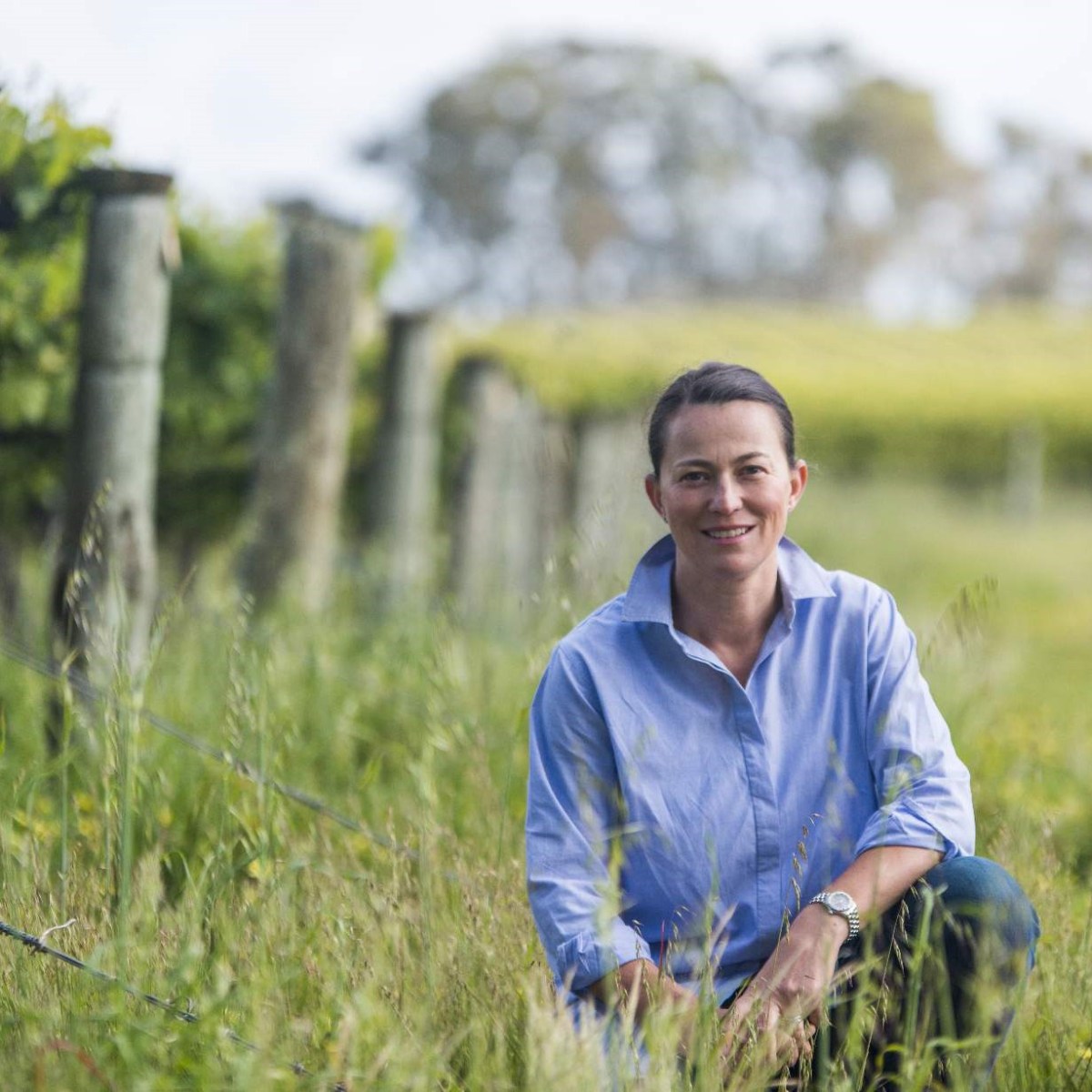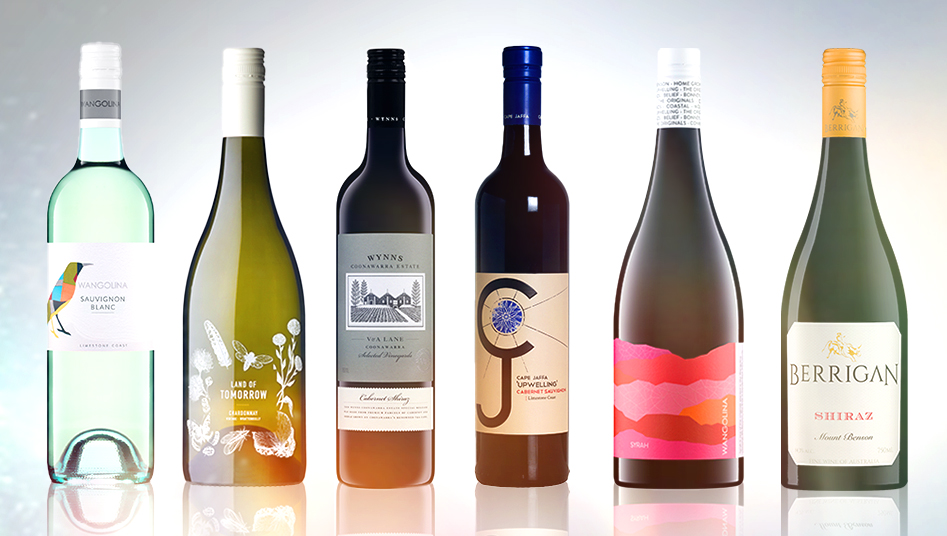Wine reviews: The ocean phenomenon shaping great SA wines
Each year a natural oceanic wonder visits our South East coastline and changes the course of the region’s wines.


Wynns Coonawarra winemaker Ben Harris is familiar with Limestone Coast ocean effects up close and in the glass. Supplied image
We hear a lot about how weather impacts grape growing and ultimately the style and characters of the resulting wines: warm and cool climates, varying altitudes, rainfall, specific vintage conditions and so on, all factor significantly.
Occasionally we see the phrase “maritime influence” come into play, where regions and vineyards close to our coastlines are affected by sea breezes, which can cool and moderate temperatures during the grape ripening seasons.
Nowhere is this more apparent than in the South East of South Australia, where a powerful oceanographic phenomenon occurs during summer and often into autumn, right when the vineyards of the Limestone Coast are coming to their fulfilment.
If you’ve ever visited the seaside town of Robe and nearby beaches, and wondered why the water, even in the middle of summer, was insanely cold, this is why.
Annually from around late December through to May, though at times it comes and goes, an event known as the Great South Australian Coastal Upwelling System brings icy water from the depths of Southern Ocean to the surface from Portland, Victoria, along the coast past Robe, Cape Jaffa and Kingston, towards Encounter Bay, then around the southern coast of Kangaroo Island and on towards Ceduna.
In the area we’re focusing on, this happening is known as the Bonney Upwelling, arriving as the prevailing winds along this section of the coast switch from westerly to south-easterly when summer kicks in.

A Bellwether Wine Instagram post celebrating the return of the Bonney Upwelling.
It’s a fascinating occurrence, the sou’easters causing warmer surface water to blow out to sea due to motion and frictional forces. That top layer is then replaced by cold water rising from the ocean floor, from as deep down as 300 metres, funnelled through a series of submarine canyons. When this cold water arrives, it can lower the sea surface temperature by several degrees.
As an aside to the Bonney Upwelling’s impact on grape growing, it also plays a big role in the life cycles of many marine organisms and supports a thriving fishing industry. The water movement encourages a rapid increase in phytoplankton which attracts swarms of krill upon which blue whales feed. The area is known as one of a dozen major blue whale feeding sites globally, though they tend to congregate offshore so are not easily viewed.
In many ways, the upwelling is a genuine natural wonder, which can be witnessed via satellite remote sensing of sea surface temperatures and chlorophyll levels, all of which assist meteorologists and biologists studying marine species.
Interestingly, this year the upwelling came late, due to what scientists believe was a warm weather snap in Antarctica last year known as a sudden stratospheric warming event. The effect of its late arrival on the wider marine ecosystem is yet to be determined.
All of this provides some context in terms of how the simple agricultural act of growing grapes, in this instance in the coastal regions of SA’s South-East, fits into a much larger natural ecosystem.
While scientists might be “witnessing” the Bonney Upwelling via satellite imaging, Limestone Coast wine vignerons on the ground know all too well of its effects on their vines.
The moderating influence of the Southern Ocean in general impacts night temperatures which wine producers firmly assess play an important role in fruit quality through long even ripening, natural grape acid retention, flavour development, colour, and tannin development and ripeness. The upwelling season takes this even further because of the strengthened sea breezes that come with it at a critical time of the year.
Anita Goode, owner, grower and winemaker at Wangolina in the Mt Benson region, admits you know you are a fully signed-up local when you find yourself in a paddock yelling at the wind. But she knows all too well its benefits during summer.
“Those colder sea breezes come in at the end of every day and really cool down the vineyard,” Goode says. “You have the day’s warmth to get the fruit ripe then it gets a chance to relax and chill down, which really helps us to capture vibrant aromatics, especially in our white varieties.”
She sees it especially in her Wangolina Sauvignon Blanc, Pinot Gris, and her Gruner Veltliner, the only source of that variety in the region. Shiraz is also enhanced with fragrance, medium-bodied styling and white pepper characters that are all indicative in cooler-climate expressions of the variety.
Shiraz also is a standout variety for Dan Berrigan of Berrigan Wines, also situated at Mt Benson. The Bonney Upwelling is one of the things that sets the Mt Benson wine region apart from all others, he says.
“It brings a steadfast consistency to the cool, maritime climate of the area and will help reduce the impact of climate change on the region’s wine styles going forward,” Berrigan suggests.
“Its cooling influence through summer allows us to have really open canopies in the vineyard without the threat of sunburn or overripe flavours in the fruit. It means we can develop intense colour and tannin in our reds, for example, yet retain wines of remarkable freshness and personality.”

Susie Harris from Land of Tomorrow Wines reckons the sea breezes reach far inland. Supplied image
While the influence of the Southern Ocean and its cold-water upwelling season is most profound on vineyards close to the coast, the impact does stretch inland as well, to the Coonawarra, Padthaway and Wrattonbully regions, the latter around 100 kilometres from the sea.
Ben Harris is a winemaker at Wynns Coonawarra Estate, as well as a champion surfer in the region who knows intimately the vagaries of local water temperatures, which he notes peak at around 17C in December but can get down to 14C to 15C in January.
And he also knows just how far the sea breezes reach inland, cooling these areas more at night while on the coast they begin dropping thermometers earlier in the afternoon. Recently during a warm spell, temperatures in the Coonawarra maxed at 30C but fell to 5C minimum.
With Wynns’ key variety Cabernet Sauvignon, these cold nights during the hotter times of the year allow the vines to continue to function without heat stress, encouraging a more even ripening period that helps produce medium-bodied wines that age with soft, fine tannins.
“We believe those cooler nights give the vines time to recover and play a big role in the balance and evenness of our wines,” Harris says.
The maritime influence is as much a player in the cool nights as the continental impact of being inland, which contributes to the region’s diurnal temperature differences. All play a part in the colour, structure, and medium-bodied expression of Coonawarra reds, especially from Wynns, he notes.
“It’s a combination of that cooling from the Southern Ocean, which is exaggerated through the months of January to March because of the Bonney Upwelling, with the generally cooler climate in the Coonawarra, and the soils and the limestone of the region,” he says.
“From a viticultural point of view, if we were to dial up exactly what we wanted, that’s when and what we would want it to be.”
Harris also has insider knowledge on a vineyard even further inland than Wynns’ Coonawarra blocks. He’s married to Susie Harris from Land of Tomorrow Wines based in Wrattonbully, who reckons the cool coastal sea breezes still get to her place east of the Naracoorte Ranges.
Land of Tomorrow grows Shiraz and Cabernet, while its Chardonnay is perhaps the highlight variety that reflects the colder evening temperatures, be they from the continental influence or the extent of the maritime cooling, or both.
The prevailing winds come from anywhere between the south-east to south-west, Susie Harris says, so there is still some oceanic effect across the whole of the larger zone.
“We are surrounded by water not that far away to the south,” she says. “And that’s a big mass of water out there.
“If you look at the Limestone Coast in comparison to the Great Southern Ocean – and one is obviously a lot bigger than the other – we do have that ocean influence wrapping around the whole coastline.”
TASTING NOTES

Wangolina Sauvignon Blanc 2022
Mount Benson-Limestone Coast / 12% / $20
Crystal clear in the glass and bursting with wild and willing tropical fruit salad aromatics. There is also that often trademark grassy sauvignon note, which adds to a more savoury taste. Intriguingly, the abundant fruit vibes abate somewhat into a more saline and minerally feel, still with a lovely tang and freshness. Moreish and mouthwatering, no wonder this is a much- awarded style. It might be hard to find as 2022 stocks dwindle, but there’s always this year’s vintage to look forward to.
Land of Tomorrow Chardonnay 2019
Wrattonbully / 12% / $35
The source of this fruit is highly sought after by elite producers as part of larger blends, so seeing this single estate iteration is a rare joy. Grown by Susie Harris and Russell Isles, and crafted by winemaker Sue Bell, the wine delivers plenty of interest – whole bunches, wild fermentation, partly matured in excellent French oak, all of which add their influences yet never dominate the glorious fruit purity in the glass. White peach, a subtle sense of grapefruit, with a delicate creaminess on the palate. Superb drinking.
Wynns V&A Lane Cabernet Shiraz 2019
Coonawarra / 12.4% / $60
Firstly note the alcohol level here, which tells us plenty about the drive by Wynns’ viticulture and winemaking teams towards elegant and medium-bodied styling in their red wine portfolio. The fruit from the estate’s blocks along V&A Lane, which marks a midway line between northern and southern Coonawarra vineyards, clearly ripens early and offers a richness in the nose and palate that suggests plush blue and black berries at their height of flavour expression. But it’s richness without weight or heaviness, hence the wine has a distinctive freshness in the tasting and finish. Deliciously drinkable at the top end of the Aussie “claret” league.
Cape Jaffa “Upwelling” Cabernet Sauvignon 2018
Mount Benson / 14.5% / $20
Over the years this Cabernet has been sourced from a range of Limestone Coast sites, though in 2018 we’re reliably informed it’s all from Mount Benson. The name, of course, refers to the regional maritime event, but also happily reflects the wine within, its varietal aromatics swelling out of the glass, familiar black berry and almost bitter dark chocolate characters are key elements in the tasting moments. Tannins are fine and offer flow-through comfort to the finish; length is stoic. A good hunk of steak or lamb will work wonders beside it.
Wangolina Syrah 2021
Mount Benson / 13.5% / $32
When Wangolina’s Shiraz (aka Syrah) estate vines were first planted in 1999, extensive windbreaks were needed on the property to protect the young growth from the assertive Southern Ocean “breezes”. These vines now bring a lot of satisfaction in the glass with vibrant royal purple colour, fragrant blue floral aromas, lucid blueberry-leaning flavours and juiciness in the drinking with underlying pepperiness in the finish. Lots to like about this cooler climate Syrah expression.
Berrigan Shiraz 2020
Mount Benson / 14.3% / $24.95
Shiraz is such a character actor, able to bend and weave to the will of multiple terroir and winemaking influences. Here we see a richer style, the fruit dark plum in its ripe flavour spectrum with definite French oak seasoning impacts across nasal and palate senses – unsurprising given 16 months of barrel maturation. Traditional Shiraz styling from a cool climate region results in a distinctive and alluring expression.




